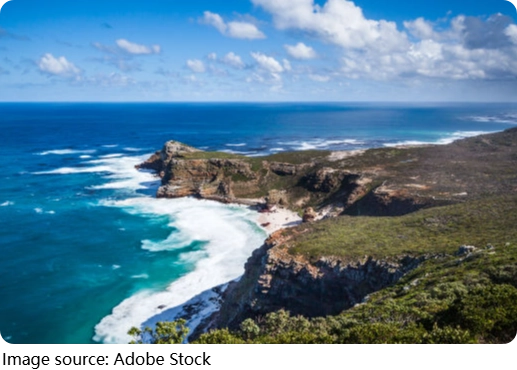Edge of Wonder

Hey Lykkers, have you ever dreamed of standing at the edge of the world? That’s exactly how it feels when we visit the Cape of Good Hope in South Africa. Known for its rugged cliffs and powerful waves, this spot isn’t just a place—it’s a symbol of adventure, discovery, and awe.
Originally named by Portuguese explorer Bartolomeu Dias, this "Cape of Storms" became the “Cape of Good Hope” as a sign of optimism on the path to the East, and trust us—it still brings that spark of hope and wonder to anyone who stands there.
Where It Is and How to Get There
The Cape of Good Hope lies within the Table Mountain National Park, around 70 km (43 miles) from Cape Town. The easiest way to get there is by car,either self-drive or as part of a guided tour. If you're not driving, join a Cape Peninsula full-day tour, which usually includes transportation, park entry, and a guide.
- Public Transport: Not recommended due to limited access.
- Car Rental: Available from Cape Town; about 1.5–2 hours drive.
- Tour prices : $40–$80 per person for day tours.

Opening Hours and Ticket Prices
Before heading out, make sure you know the opening times and fees:
Opening Hours:
- September to March: 6:00 AM – 6:00 PM
- April to August: 7:00 AM – 5:00 PM
Entrance Fees:
- International Adults: $16
- International Children: $8
- South African Citizens: Local rates available with ID
The ticket gives us access to both Cape Point and the Cape of Good Hope area within the national park.
What to See and Do: Beyond the Signpost
Everyone loves taking photos with the "Cape of Good Hope" signpost, but the real magic lies in exploring more:
- Cape Point Lighthouse: Ride the Flying Dutchman Funicular or hike up to the top for jaw-dropping ocean views.
- Funicular round trip: ~$5
- Hiking Trails: Several scenic trails for different fitness levels. The Cape of Good Hope Trail is a 3.5 km (2.2 miles) loop that’s great for photos and nature watching.
- Dias Beach: A quiet stretch of white sand and rocks, perfect for a peaceful moment with the sea.
- Wildlife Spotting: Look out for ostriches, baboons, antelopes, and seabirds. They roam freely in the reserve.
Best Time to Visit
The Cape can be windy and wild, so timing matters:
- Best Season: Late spring (October to December) and autumn (March to May) offer pleasant weather and fewer crowds.
- Avoid: Peak winter months (June to August), when it’s rainy and colder.
- Time of Day: Mornings are usually less windy and better for hiking.
Tips for a Smooth Visit
We’ve learned a few tricks during our trip that can make your's even better:
1. Bring a Windbreaker: Even in summer, the wind here is fierce—especially near the cliffs.
2. Watch Out for Baboons: They may look cute, but they’re clever and can open car doors to steal food. Don’t feed them.
3. Start Early: To enjoy the peaceful views without the crowd, arrive around park opening time.
4. Don’t Skip the Lookout Point: From there, we can see the line where the Atlantic and Indian Oceans seem to meet—an unforgettable view.
5. Postcards and Stamps: You can buy a Cape of Good Hope postcard, stamp it with the special postmark, and mail it from the red postbox at the tram station—such a unique souvenir!
Where to Eat and Shop
At Cape Point, there’s the Two Oceans Restaurant, offering seafood and ocean views. While prices are mid to high range ($10–$30 per meal), it’s worth it for the location. Souvenir shops are nearby, selling t-shirts, magnets, and crafts themed around the Cape.
Feel the Power of Nature
Standing on the cliffs, surrounded by roaring waves and endless blue, we truly feel what it means to be at the “end of the world.” Whether it’s the sea breeze, the golden sunset, or the raw cliffs beneath our feet, every part of this place touches the soul. When the clouds roll over and waves slam into the rocks, we’re reminded just how mighty nature can be.
Let’s Leave Our Footprints at the Edge
So Lykkers, are you ready to leave your footprints at the edge of the world? The Cape of Good Hope is more than a photo spot—it’s a living piece of Earth’s story. With wild beauty, peaceful trails, and iconic views, it’s a place where we can feel both tiny and alive. Don’t forget to write a postcard to yourself from the Cape—you’ll want to remember how it felt to stand there.
Let’s go where land meets sea—and adventure begins.
End of the World: Cape of Good Hope | Cape Peninsula | South Africa | Multiverse Travel
Video by Multiverse Travel
-
 Above the SerengetiSoaring Over Lions and Wildebeests? Here’s Everything You Need to Know Before a Hot Air Balloon Ride in the Serengeti!
Above the SerengetiSoaring Over Lions and Wildebeests? Here’s Everything You Need to Know Before a Hot Air Balloon Ride in the Serengeti! -
 Discover East SussexYou Won’t Believe How Beautiful East Sussex Is—Secret Beaches, Castles, and Cozy Towns Await Your Next Trip!
Discover East SussexYou Won’t Believe How Beautiful East Sussex Is—Secret Beaches, Castles, and Cozy Towns Await Your Next Trip! -
 Timeless Dutch WindmillsYou Won’t Believe How Stunning Dutch Windmills Are – Discover Hidden Tips to Make Your Visit Unforgettable!
Timeless Dutch WindmillsYou Won’t Believe How Stunning Dutch Windmills Are – Discover Hidden Tips to Make Your Visit Unforgettable!